 SELECTED
ISSUE
SELECTED
ISSUE
|
|
Leisure Management - Multi story

Multimedia and AV

|
|
| Multi story
|

Travelling back through time at Stonehenge, understanding what it was like to be a sailor 100 years ago and witnessing new discoveries about ancient Egyptian mummies are among the latest multimedia and AV projects
|
|
|

|
Life on the waves

Acentury-worth of experiences in the Royal Navy can now be heard at The National Museum of the Royal Navy’s new £11.5M (US$19.3m, E14m) visitor attractions.
Located within Portsmouth Historic Dockyard, UK, home of the Royal Navy, the museum launched two new exhibitions in April. DJ Willrich worked on HMS Hear My Story, a dedicated exhibition in the new £4.5M (US$19.3m, E14m) permanent Babcock Galleries, and the re-launch of HMS Alliance. After a £7M ($11.8m, E8.5m) conservation and restoration project, the only surviving WWII era submarine is now a memorial to 5,300 submariners.
The DJ Willrich AV installation helps interpret 1,000 stories spanning 100 years for HMS Hear My Story. The centrepiece audio visual exhibit is a multi-touch timeline where six people can bring up photos, text and video footage of people and ships from the across the history of the Navy. Each of the six 46” (1.2m, 4ft) screens that form the table has its own timeline, but naval vessels from the whole period float across screens, puff steam, blow their horns and aircraft take off from carriers. As well as being of interest to all, this is a particularly valuable resource for the museum’s education team. A glass top covers the screens, providing a single touch surface – and one that is easy to maintain with all the touches it receives.
“The custom built table’s designed to be high enough to fit wheelchairs underneath, so all visitors can get close to the table,” says project manager at DJ Willrich Nicola Jagger. “This created a challenge as there’s very little space underneath to store equipment. Also, there is no natural way for the heat from the screens to dissipate, so we developed a quiet water-based cooling system to keep everything at safe operating temperatures.” Touch sensors were custom built and supplied by Displaylite; Elbow provided the software throughout the exhibition and Elmwood was the lead contractor.
Another particularly interactive area of the exhibition encourages visitors to vote on more contentious issues related to the Navy, such as whether women should continue to serve on submarines and whether the Navy should receive more money. Past and present sailors, families and visitors give their view before visitors vote at one of eight voting stations. Three micro computers send the votes across the network to the game PC where they are collated and visitors can see how their responses compare with others.
Elsewhere visitors are immersed in video where they see and hear what it was like to be involved in actions from the Battle of Jutland in 1916 to the Falklands War in 1982. Subtitles and British Sign Language are available on every video with spoken voice. Interactives let visitors hear more of the stories of those who have served, as well as discover where the Navy is serving now, in updatable databases.
| |
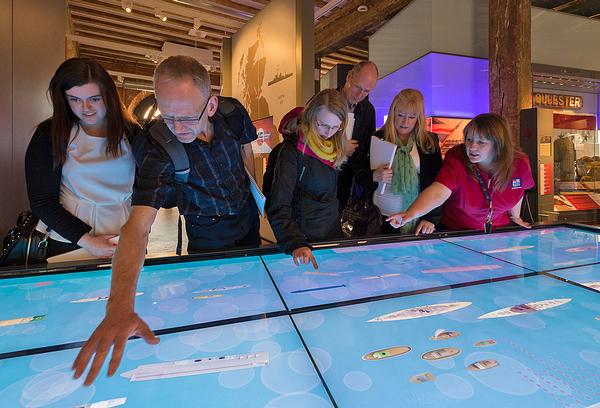

|
| © the national museum of the royal navy |

The centrepiece exhibit allows six people at a time to bring up photos, texts and video of ships from history |
|

|
Beer goggles

The recently opened brew cinema at Stiegl Brauwelt offers visitors a visual beer experience. The walk-in cinema, which is designed as a multi-dimensional projection space, provides a fresh insight into the world of beer and its origins using a panorama film in five languages with a floor projection onto a 200sq m (2,150sq ft) surface.
The film is projected onto a semicircular 24 x 4m (79 x 13ft) wall using four projectors, providing a seamless wide screen image. The four full-HD Panasonic projectors produce soft edge blending with an overlap of 20 per cent. The floor projection also consists of four images that overlap, which is achieved by using eight Hitachi projectors with extreme wide angle lenses. The live action movie has a total projection area of 180 degrees with 3D animations and was produced at cinema standard 5.5 K (Camera Red Epic). This achieved a quality (5120 x 2560 pixels) which is a six times higher resolution than that of HDTV. A water wall was also integrated, which can be started and stopped manually and also lit in RGB colours matching the film.
The entire installation uses AV Stumpfl show control technology and is controlled centrally using AV Stumpfl Wings Touch and Avio.
| |
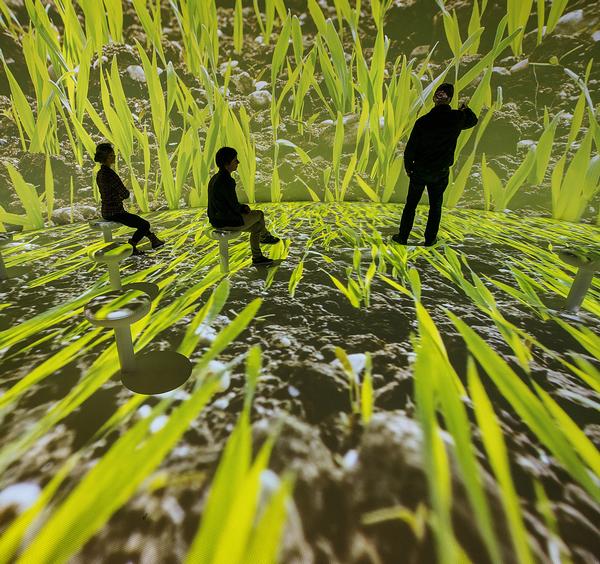

|

The walk-in cinema immerses visitors in a panorama film (available in five languages) with floor projection |
|

|
Caped crusade

Anew Batman-branded laser maze attraction has been created by SimEx-Iwerks, working exclusively with Warner Bros Consumer Products on behalf of DC Entertainment. The first of its kind, the Batman Laser Challenge expands on the laser maze model by infusing a powerhouse brand to enhance the experience and appeal to a broad demographic.
The Batman Laser Challenge delivers an action-packed adventure that features high-visibility lasers, UV lighting, branded elements, character dialogue, music and special effects.
The Batman Laser Challenge requires minimal space, has a throughput capacity of 30 to 40 guests per hour and can perform s a stand-alone attraction or as a complement to a 4D theatre.
The experience has single and double maze configurations and challenges guests to train with Batman to protect citizens of Gotham City™ from The Joker. The first Batman Laser Challenge debuted in March at the Adventuredome Theme Park in the Circus Circus Hotel & Casino in Las Vegas.
| |
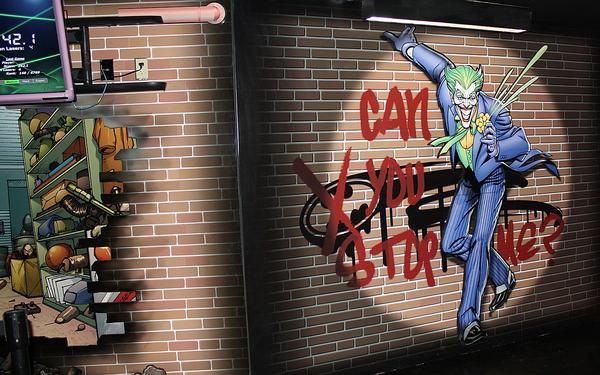

|

The Batman attraction uses high-visibility lasers, branding, character dialogue, music and special effects |
|

|
Precious stones

The new Stonehenge exhibition and visitor centre makes dramatic use of high resolution projection technology to help visitors learn about one of the world’s most important prehistoric monuments. Electrosonic completed the audio-visual (AV) systems design and integration.
The centre, located 1.5 miles from Stonehenge itself, is the main phase of English Heritage’s £27m ($45m, E33m) project to transform the visitor experience of this iconic site. To date, it is their largest ever capital investment project. (See feature in AM Q1 14.)
AV technology is used to give visitors an enthralling introduction to the legend of the Stones, exploring the history and debate surrounding this ancient monument. One of the main highlights is the Standing in the Stones exhibit, a 360-degree virtual experience. Installed by Electrosonic, the exhibit lets visitors stand in a virtual Stonehenge as it is today and in the past. The three-minute film, based on laser scan images of the stone circle, transports viewers back in time through the millennia, enabling them to experience the summer and winter solstices.
Standing in the Stones uses six Panasonic PT-DZ770 single chip DLP™ projectors with 1920x1200 resolution and nominal 7000 lumen light output. These are sourced from a 7th Sense Delta server via Atlona extenders. The audio chain includes a BSS BLU 100 DSP, four Crown CTs600 amplifiers and seven Tannoy Di5 loudspeakers augmented by a ceiling mounted sub bass loudspeaker.
Visitors move onto the Meaning section, which includes four portrait format 32-inch LCDs showing a linear programme on the debate around the Meaning of Stonehenge. Landscape, the largest AV element, is a giant image of the Stonehenge World Heritage Site projected onto a wall screen which shows how people changed the landscape over the pre-historic period. The exhibit uses three Panasonic PT-DX610ELKsingle chip DLP™ projectors with XGA resolution and 6500 lumen output from a 7thSense Delta server via Atlona extenders.
The centre also has an education space equipped with appropriate room control and AV facilities. The space can be divided into two – one half has a ceiling mounted Panasonic VW435NEA LCD projector with WXGA resolution, and the other half has an 87-inch Smartboard touch screen. Room control is by a Crestron MC2E controller.
Haley Sharpe Design managed the production of the exhibition, with The Hub as exhibition fit-out contractor and Goppion as supplier of the display cases. Standing in the Stones was produced by Centre Screen productions, assisted by Studio Liddell and with a sound track by Peter Key. Content for the Meaning displays, the LCDs in the display cases and for the ticket office audio guide was produced by ISO Design, and the Landscape content was produced by Squint Opera.
| |
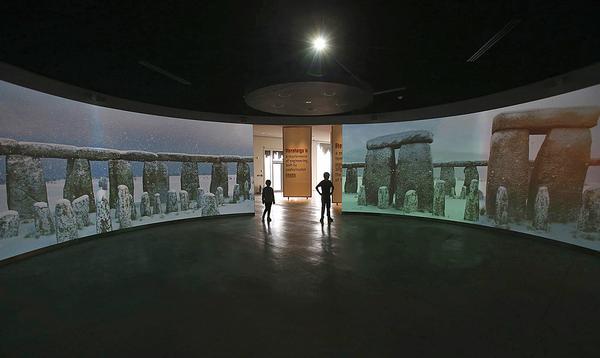

|

AV technology is used to give visitors an enthralling introduction to the legend of the Stones |
| |
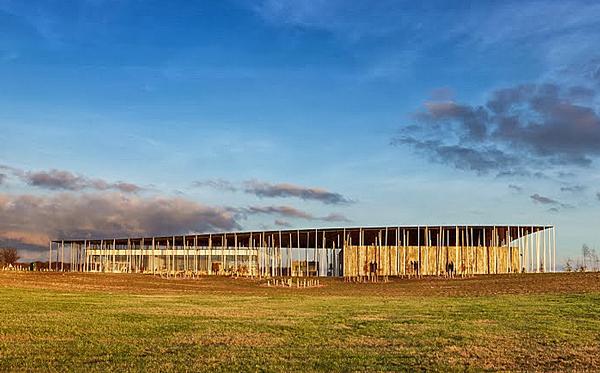

|
| AV technology is used to give visitors an enthralling introduction to the legend of the Stones |
| |
|

|
Home run

Major League Baseball is celebrated at the new St Louis Cardinals Hall of Fame and Museum. Multimedia is used to showcase and explore thousands of stories, victories and heroes from the late 1800s to today. At almost 8,000sq ft (743sq m), the museum pays tribute to the great players through artefacts, storyboards, video and interactive exhibits.”
Conceived and designed by PGAV Destinations, the museum walks visitors through the history of the Cardinals, from the early days of Sportsman’s Park through today’s celebrated stadium and team. Using a series of galleries, each stage of the museum is designed to reflect the historic stadium architecture and the period being explored, through changing photographic pallets, case designs, and park aesthetics.
Highlights of the gallery include the Broadcast Booth, where visitors can record their own sportscaster broadcast of thrilling Cardinals moments and the opportunity for fans to “interview” four recent Cardinals managers to get their different thoughts on challenging baseball topics. They can also explore touch screens, which display statistics in real-time of the current roster.
| |
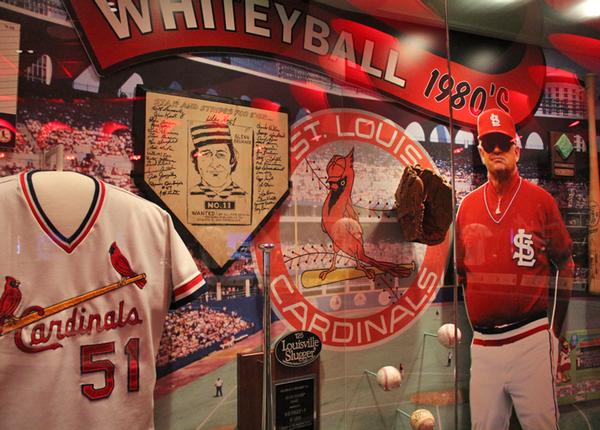

|

The museum showcases thousands of team stories, victories and heroes |
|

|
It’s a wrap

Anew exhibition at The British Museum unveils new discoveries from CT scanning, which tell the different stories of eight individuals who were mummified thousands of years ago.
The mummies selected for the Ancient lives, new discoveries exhibition cover a period of more than 4,000 years, from the Predynastic period to the Christian era, from sites in Egypt and the Sudan. The emphasis will be on revealing different aspects of living and dying in the ancient Nile valley through these eight individuals and also through contextual objects from the collection such as amulets, canopic jars, musical instruments and items of food.
Holovis worked with the museum’s technical staff to install a mix of screens and projectors. These bring the exhibition’s messages to life, creating engagement while being empathetic with the real life stories being told.
Ancient lives, new discoveries follows the successful British Museum international touring exhibition Mummy: the inside story. For this, Holovis created a 3D 4K-resolution theatre that immersed the audience in the virtual unwrapping of a 3,000-year old mummy.
From 2011 to 2013 this exhibition travelled to venues in Virginia, Brisbane, Mumbai and Singapore, accompanied and supported technically by Holovis throughout the tour.
| |
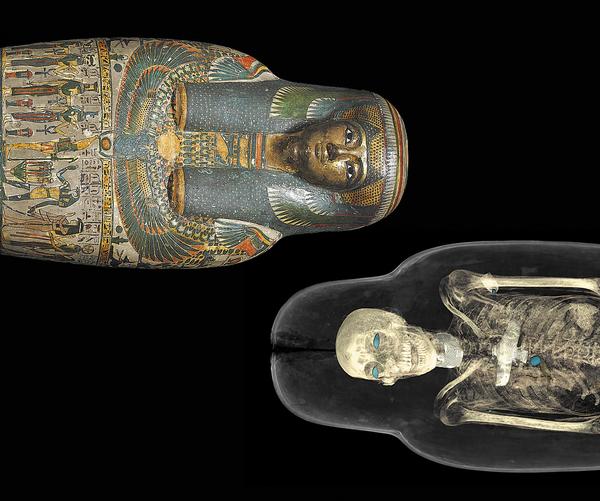

|

The new exhibition tells the different stories of eight people who were mummified thousands of years ago |
|

|
Going live

The ability to make instant, last-minute decisions for live events was the main requirement at The Works Theater at Carnegie Science Center in Pittsburgh when it recently needed an equipment upgrade.
The centre is dedicated to educating, entertaining and inspiring through programmes in science, sports and technology. To showcase demonstrations in The Works Theater’s industrial setting, Alcorn McBride’s V16 Pro top-of-the-line controller was chosen.
Doug DeHaven, AV specialist/robotics at Carnegie Science Center, paired the robust hardware of the V16 Pro with easy programming of QLab software as the multimedia cueing platform. “Our theatre has a lot of hardware,” he says. “We have a 100-year-old 10ft (3m)-tall, 1.2 million volt Tesla Coil that we need to control. We also have a liquid nitrogen fog machine that takes a lot of control to make it work right. Plus two pan-tilt-zoom cameras and eight video projectors for the screens that ring the theatre. We need to run their content and turn the projectors on and off.”
DeHaven specified, designed and installed the system and infrastructure and programmed the V16 Pro and touch interface. He also designed the communication protocol between the devices and systems. “We not only wanted the reliability and interfacing capability of Alcorn equipment but also the ability to make realtime show control changes for live events – we have multiple different shows in one space through the day,” says DeHaven. “I found a way to marry Alcorn and QLab products to accomplish this.”
| |


|

The centre is dedicated to educating and entertaining through science, sports and technology programmes |
|
 |
| Originally published in Attractions Management 2014 issue 2
|
|
 |
|
|
|
|
|
| | | |